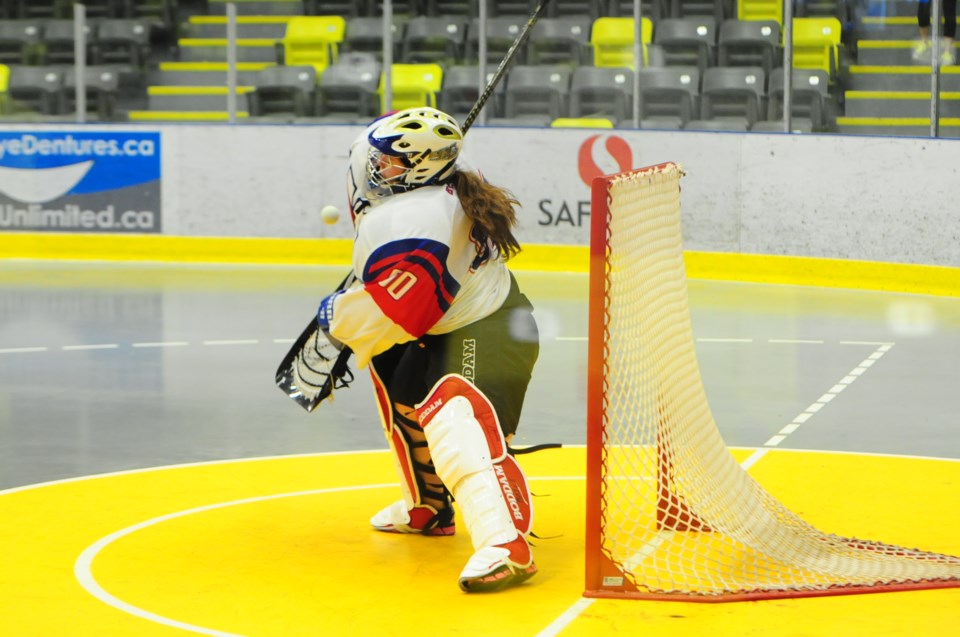By any marker, girls’ lacrosse is a big success in New West.
There are currently about 250 girls in the city who play box lacrosse and about 80 who play field lacrosse within the New Westminster Salmonbellies minor lacrosse association.
Many of the teams, at all levels, have won championships or come close.
The 2014 female box lacrosse provincial championship results are an example of the prowess of the girls of the Royal City.
The junior Salmonbellies earned bronze, the midget teams won both silver and bronze. In bantam, the ‘Bellies won two silver and one bronze. The peewees earned two bronze.
“There are a lot of dads, who are Hall of Famers with the Western Lacrosse Association and the National Lacrosse League and pros, who are coaching their daughters, and these guys bring an unbelievable coaching skill level,” said Shawn House, British Columbia Lacrosse Association’s (BCLA) past chair of girls’ box lacrosse.
Playing field lacrosse, in particular, can be lucrative for female Salmonbellies.
‘Bellie Emily Manville, 16, is likely headed to Columbia University next fall thanks to a field lacrosse scholarship. Manville, a New Westminster Secondary senior, has a verbal commitment to attend the New York school and play for the Columbia Lions.
“I am definitely proud of New West because we always have more than one women’s team when we play in box, and no other association can put forward that many girls,” she said. “I really like that girls’ lacrosse in general has developed as much as it has and that I could be a part of that.”
Judging by the success of the girls of New West, it is hard to imagine that a mere 10 or so years ago, there were no girls’ lacrosse teams in the Royal City. What female players there were, played on mixed teams.
(Historically, there were all-girls’ lacrosse teams in New Westminster, but they petered out in the late 1980s when lacrosse in general saw numbers decline.)
House is credited by many with developing the girls’ teams in New West and the sport for girls in British Columbia.
When House was coaching his son and daughter’s mixed mini-tyke team, in about 1996, there were around seven girls on his team.
“Typically what they did when there was girls, if there were four teams and there was four girls, then each team took a girl.
My daughter was one of the seven…and they told her to pick a friend,” he said.
His daughter, who was six at the time, was in tears trying to pick just one friend to stay with her on her team and so the coaches decided House’s team could keep all seven girls in exchange for first pick of the boys.
“That was kind of the genesis of it,” said House.
His daughter quit when she became a novice, as many girls did at the time, because at that level there was physical contact on the mixed teams. Eventually the Salmonbellies executive asked House if he could get his daughter and her old teammates together to form an all-girls team.
(The rules for girls have evolved over the years. There is no contact at the younger levels, but as girls get older there is modified contact.)
“I got my old team list out, phoned all those girls I had as mini-tykes three years earlier and all of them said yes,” he said.
The first year the girls’ team played Coquitlam, the only other girls’ team in the Lower Mainland.
As time went on, more and more girls joined the ‘Bellies.
Three years later there were three New West teams. “It caught on,” House said.
House was supported by other parents, coaches and administrators of the game who wanted the girls’ to have the same chances at the sport as their brothers.
“We gave girls the best opportunity to play, we used to pick the times to practice based on seniority and the junior girls went all the way up to 21. The oldest boy in minor lacrosse goes up to 16 so suddenly New West junior girls got the best times,” said past president of the minor Salmonbellies, Jamie Stewart, who has coached various girls teams over the years.
“I think that was huge. So no longer were the girls having to practice at whatever time on Saturday night, they had Tuesday afternoons and the perfect times,” Stewart said.
Girls’ have been joining in droves since.
Currently there are about 12 girls’ Salmonbellie teams in box lacrosse and about 60 in the province.
(Girls field lacrosse developed a few years later as girls who played box, picked up field in the off season.)
There was no provincial competition for the girls’ box teams for the first five or six years. House wanted to allow the girls’ the highest level of competition so he took the idea to the BCLA in about 2004.
“It was definitely met with some resistance because on the provincial side of things there were definitely people who felt, ‘Well, girls don’t even play. Why are they even playing? It is a man’s game.’ It took some doing,” he said.
It took five years for the provincial competition to be established and then Team B.C evolved- an all-star team made up of girls from across the province that represents B.C. at the Canadian National Championships.
“It is quite a success story for girls in New West,” said House



